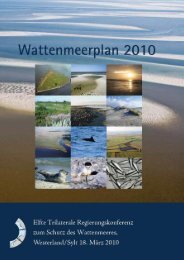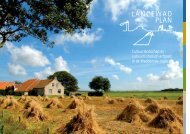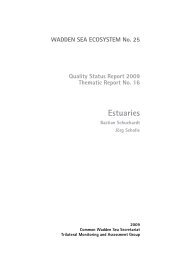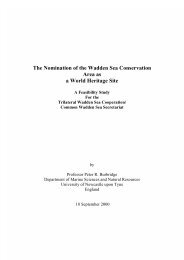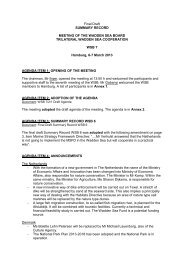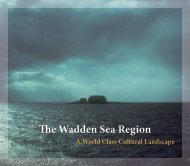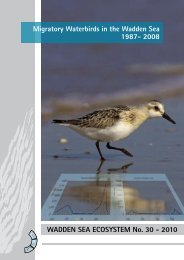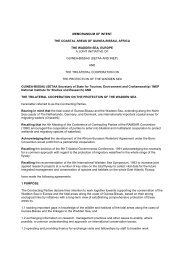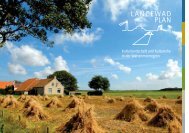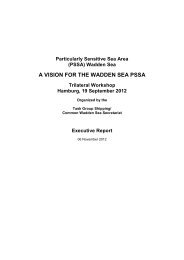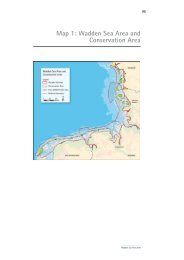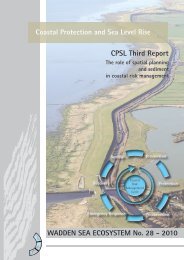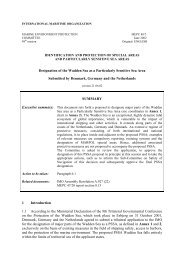Landsape and Cultural Heritage - Trilateral Wadden Sea ...
Landsape and Cultural Heritage - Trilateral Wadden Sea ...
Landsape and Cultural Heritage - Trilateral Wadden Sea ...
Create successful ePaper yourself
Turn your PDF publications into a flip-book with our unique Google optimized e-Paper software.
WADDEN SEA ECOSYSTEM No. 26<br />
Quality Status Report 2009<br />
Thematic Report No. 2<br />
<strong>L<strong>and</strong>sape</strong> <strong>and</strong> <strong>Cultural</strong> <strong>Heritage</strong><br />
Meindert Schroor<br />
2 L<strong>and</strong>scape <strong>and</strong> <strong>Cultural</strong> <strong>Heritage</strong><br />
Joachim Kühn<br />
Nigel Brown<br />
Jens Enemark<br />
Manfred Vollmer<br />
2009<br />
Common <strong>Wadden</strong> <strong>Sea</strong> Secretariat<br />
<strong>Trilateral</strong> Monitoring <strong>and</strong> Assessment Group<br />
<strong>Wadden</strong> <strong>Sea</strong> Ecosystem No. 23 � 2007
2<br />
2 L<strong>and</strong>scape <strong>and</strong> <strong>Cultural</strong> <strong>Heritage</strong><br />
<strong>Wadden</strong> <strong>Sea</strong> Ecosystem No. 23 � 2007<br />
Colophon<br />
Publisher<br />
Common <strong>Wadden</strong> <strong>Sea</strong> Secretariat (CWSS), Wilhelmshaven, Germany;<br />
<strong>Trilateral</strong> Monitoring <strong>and</strong> Assessment Group (TMAG).<br />
Editors<br />
Harald Marencic, Common <strong>Wadden</strong> <strong>Sea</strong> Secretariat (CWSS)<br />
Virchowstr. 1, D � 26382 Wilhelmshaven, Germany<br />
Jaap de Vlas, Rijkswaterstaat, Waterdienst<br />
Lelystad, The Netherl<strong>and</strong>s<br />
Language support<br />
Marijke Polanski<br />
Lay�out <strong>and</strong> technical editing<br />
Common <strong>Wadden</strong> <strong>Sea</strong> Secretariat<br />
Graphic support<br />
Gerold Lüerßen<br />
Published<br />
2009<br />
ISSN 0946�896X<br />
This publication should be cited as:<br />
Schroor, M., Kühn, J., Brown, N., Enemark, J., Vollmer, M., 2009. L<strong>and</strong>scape <strong>and</strong> Culture. Thematic Report<br />
No. 2. In: Marencic, H. & Vlas, J. de (Eds), 2009. Quality Status Report 2009. <strong>Wadden</strong><strong>Sea</strong> Ecosystem No.<br />
26. Common <strong>Wadden</strong> <strong>Sea</strong> Secretariat, <strong>Trilateral</strong> Monitoring <strong>and</strong> Assessment Group, Wilhelmshaven,<br />
Germany.
. Development <strong>and</strong> cultural<br />
history of the tidal <strong>Wadden</strong> <strong>Sea</strong><br />
area<br />
The <strong>Wadden</strong> <strong>Sea</strong> is the most dynamic natural<br />
l<strong>and</strong>scape of Western Europe. The sea, its isl<strong>and</strong>s<br />
<strong>and</strong> coastal surroundings together form an ever<br />
shifting ‘monument’ of topographical changes. As<br />
a consequence, the history of the <strong>Wadden</strong> <strong>Sea</strong> is<br />
a fine example of man coping with his environ�<br />
ment, by trial <strong>and</strong> error as well as by expansion<br />
<strong>and</strong> contraction. Socio�economically it is a good<br />
example of a society based both on agriculture<br />
<strong>and</strong> maritime activities (sailing, fishing, salvage<br />
<strong>and</strong> reclamation). Large parts of what is now l<strong>and</strong><br />
were sea about 1,000 years ago <strong>and</strong> vice versa.<br />
The Marne�estuary (south of Harlingen), the Mid�<br />
delsea�inlet with It Bildt, the inlets <strong>and</strong> former<br />
estuaries of rivers like the Lauwers, the Hunze<br />
<strong>and</strong> the Fivel were all part of the <strong>Wadden</strong> <strong>Sea</strong><br />
<strong>and</strong> have since been reclaimed. The same goes for<br />
the bays <strong>and</strong> gulfs of Campen, Sielmönken, Harle<br />
<strong>and</strong> Maade in East�Frisia <strong>and</strong> Oldenburg (both in<br />
Lower Saxony).<br />
Prehistoric <strong>and</strong> Medieval Times<br />
At the end of the last Ice Age, the <strong>Wadden</strong> <strong>Sea</strong><br />
area was dryl<strong>and</strong>, with the coast located to the<br />
west of the present Dogger Bank. Finds recovered<br />
during dredging or fishing in this marine environ�<br />
ment have established that the area hosted large<br />
herds of animals <strong>and</strong> b<strong>and</strong>s of hunter�gatherers.<br />
However, as sea�levels rose the inhabitants must<br />
have retreated back to the current shoreline. There<br />
are undoubtedly Palaeolithic <strong>and</strong> Mesolithic sites<br />
under the present <strong>Wadden</strong> <strong>Sea</strong>, buried beneath<br />
many metres of sediment.<br />
There is more information for the Neolithic pe�<br />
riod. For example, many finds have been recovered<br />
from the <strong>Wadden</strong> <strong>Sea</strong> Area between the Eiderstedt<br />
peninsula <strong>and</strong> the isl<strong>and</strong> of Föhr, including late<br />
Neolithic <strong>and</strong> early Bronze Age flint daggers <strong>and</strong><br />
flint sickles. These, prove the presence of people<br />
in this area in the late 3rd <strong>and</strong> early 2nd millennium<br />
BC, <strong>and</strong> probably even human settlement. Some<br />
undisturbed sites have also provided information<br />
about the surface level of the marsh 4,000 years<br />
ago. Middle Neolithic finds are often recovered<br />
on the coasts of Fanø. The finds must originate<br />
from submerged hunting camps <strong>and</strong> are washed<br />
ashore. The most outst<strong>and</strong>ing find is a stylised bear<br />
2 L<strong>and</strong>scape <strong>and</strong> <strong>Cultural</strong> <strong>Heritage</strong><br />
. Historic Development <strong>and</strong> Characterization<br />
. Historic development <strong>and</strong> characteristics of the cultural<br />
heritage in the <strong>Wadden</strong> <strong>Sea</strong> Region<br />
made of amber. Today the level is 1.50 m below<br />
sea level (NN), but the spatially varying subsidence<br />
of glacial sediments must be taken into account.<br />
So far, there are no artefacts from the following<br />
periods, the late Bronze Age <strong>and</strong> the pre�Roman<br />
Iron Age, from the northern coastal marshes. Finds<br />
of the 2 nd to 5 th century AD have been recovered<br />
from an area between the Japs<strong>and</strong> west of the<br />
Hallig isl<strong>and</strong> of Hooge <strong>and</strong> the isl<strong>and</strong> of Pellworm<br />
demonstrating that by the 2 nd century A. D. people<br />
had returned to the southern parts of the <strong>Wadden</strong><br />
<strong>Sea</strong> Area of North Frisia. In Roman times a large<br />
part of the <strong>Wadden</strong> <strong>Sea</strong> south of an imaginary<br />
line between Texel <strong>and</strong> Zurich (Friesl<strong>and</strong>) were in<br />
fact raised bogs fringed by a rather narrow belt<br />
of marshl<strong>and</strong>.<br />
There appears to have been a general ab<strong>and</strong>on�<br />
ment of settlements across the region during the<br />
late Roman Iron Age <strong>and</strong> the Migration period,<br />
probably due to rising sea�levels <strong>and</strong> storm�tides<br />
in the 4th century. Settlement recommences in<br />
the 7 th or 8 th centuries, often in areas that had<br />
been previously favoured as settlement sites in<br />
the Roman Iron Age. However, these settlements<br />
were always vulnerable to storm�tides, of which<br />
the most famous <strong>and</strong> best recorded is probably<br />
the Grote M<strong>and</strong>ränke or ‘Great Drowning’ of 1362<br />
which devastated the entire <strong>Wadden</strong> <strong>Sea</strong> region,<br />
submerging villages <strong>and</strong> isl<strong>and</strong>s <strong>and</strong> re�modelling<br />
the entire coastline.<br />
As a remnant of a partly drowned l<strong>and</strong>scape,<br />
archaeological traces of former settlements can be<br />
found or are historically documented throughout<br />
the <strong>Wadden</strong> <strong>Sea</strong>. Visible fragments of human oc�<br />
cupation like the remnants of drowned villages,<br />
houses <strong>and</strong> farms may be found in the Jadebusen,<br />
but also off the mainl<strong>and</strong> coast near Neuharlin�<br />
gersiel (Otzum, Ostbensum), off the Westermarsch<br />
(Itzendorf) <strong>and</strong> off L<strong>and</strong> Wursten (Rintzeln <strong>and</strong><br />
Reminzeln).<br />
Other remains, although mostly washed away<br />
or submerged, may be assumed elsewhere, espe�<br />
cially off Texel <strong>and</strong> Wieringen (Balgz<strong>and</strong>), near<br />
the small isl<strong>and</strong> of Griend, off the north�coast of<br />
Fryslân (villages like Biniathorp <strong>and</strong> Dikesherne<br />
are historically documented near Harlingen) <strong>and</strong><br />
most of all in the Dollard. Reclamation has led<br />
to the excavation of traces of occupation on the<br />
mainl<strong>and</strong> around former coastlines. They all need<br />
to be documented <strong>and</strong> protected.<br />
<strong>Wadden</strong> <strong>Sea</strong> Ecosystem No. 23 � 2007
2 L<strong>and</strong>scape <strong>and</strong> <strong>Cultural</strong> <strong>Heritage</strong><br />
Figure 1:<br />
The <strong>Wadden</strong> <strong>Sea</strong> Region<br />
with the defined cultural<br />
entities.<br />
<strong>Wadden</strong> <strong>Sea</strong> Ecosystem No. 23 � 2007<br />
Large areas of peat, <strong>and</strong> the salt deposits found<br />
in it, had been extracted systematically since the<br />
High Middle Ages. There is archaeological evi�<br />
dence of the extraction of salt peat in a narrow<br />
strip reaching west�east, from the Hallig isl<strong>and</strong>s<br />
of Hooge, Langeneß, Ol<strong>and</strong>, Gröde <strong>and</strong> Habel to<br />
the mainl<strong>and</strong> marshes <strong>and</strong> north to the southern<br />
periphery of the Wiedingharde. Many traces of salt<br />
peat extraction have already been eroded by the<br />
North <strong>Sea</strong>, others have been covered by mainl<strong>and</strong><br />
marshes, Hallig isl<strong>and</strong>s <strong>and</strong> mudflats. Extensive<br />
erosion south of the Hallig isl<strong>and</strong> of Langeneß has<br />
led to the temporary exposure of peat extraction<br />
sites enclosed by former inl<strong>and</strong> dykes<br />
Salt was a much sought after commodity as the<br />
town charters of Ribe, Flensburg <strong>and</strong> Schleswig<br />
document <strong>and</strong> the extraction <strong>and</strong> trade of salt<br />
brought some temporary prosperity to the coast<br />
dwellers involved. This is mirrored in the distribu�<br />
tion of s<strong>and</strong>stone sarcophagi imported from the<br />
Rhinel<strong>and</strong> <strong>and</strong> Weser area <strong>and</strong> the correspondence<br />
between the distribution patterns of sarcophagi<br />
<strong>and</strong> extraction areas of salt peat were surely not<br />
accidental. The great flood of 1362 (M<strong>and</strong>ränke)<br />
caused the collapse of this flourishing salt�extrac�<br />
tion industry. After 1362 the extraction of salt<br />
from previously untouched areas shows the lack<br />
of interest in the restoration of protective dykes<br />
destroyed by the M<strong>and</strong>ränke. The boom years of<br />
salt trade in North Frisia, however, were over.<br />
Early Modern Times<br />
The <strong>Wadden</strong> <strong>Sea</strong> area in early modern times is<br />
characterised by three great themes; reclamation,<br />
international maritime conflict <strong>and</strong> international<br />
trade.<br />
In the southern part of the <strong>Wadden</strong> <strong>Sea</strong> the<br />
remnants of the old dam to Amel<strong>and</strong> can be seen<br />
(the relict of a failed attempt in 1871�1882 to<br />
connect this isl<strong>and</strong> to the mainl<strong>and</strong> as a first step<br />
in reclaiming this part of the <strong>Wadden</strong> <strong>Sea</strong>). It is still<br />
visible during the ebb tide <strong>and</strong> is worth protect�<br />
ing from a cultural�historical point of view. Other<br />
dams like the Geise Leitdamm (opposite Emden),<br />
the Pollendam (near Harlingen), the Nieuwe Dam<br />
(West�Terschelling), <strong>and</strong> the dams alongside the<br />
river Weser by Ludwig Franzius, were built <strong>and</strong><br />
function as training walls to influence the cur�<br />
rent. Minsener Oog was the result of an early 20 th<br />
century attempt to deepen the Jade channel.<br />
On the mud�flats bordering the salt marshes,<br />
ditches <strong>and</strong> warping dams are witnesses of recent<br />
l<strong>and</strong> reclamation. The most famous dam is the<br />
Afsluitdijk. This barrier dam, which is almost 30
km long was completed in 1927�1932 <strong>and</strong> joins<br />
the coasts of the former isl<strong>and</strong> of Wieringen <strong>and</strong><br />
Friesl<strong>and</strong>. The Zuyder Zee was enclosed <strong>and</strong> shut<br />
off from its northern part with this great enclo�<br />
sure dike. The former mouth of the Zuyder Zee<br />
is now the subtidal western part of the Dutch<br />
<strong>Wadden</strong> <strong>Sea</strong>.<br />
In the northern half of the <strong>Wadden</strong> <strong>Sea</strong>, the<br />
coastal dwellers of Dithmarschen proved to be<br />
as successful in the reclamation of new polders<br />
during early modern times as they had been<br />
in the Middle Ages. In North Frisia, however, it<br />
proved impossible to reclaim all the coastal l<strong>and</strong><br />
that had been cultivated during the Middle Ages.<br />
Archaeological finds show that during the 16 th <strong>and</strong><br />
early 17 th century those areas which succeeded in<br />
empoldering at least parts of the coastal marshes<br />
gained in prosperity. The increase in affluence was,<br />
however, short�lived <strong>and</strong> as early as the 1 st half of<br />
the 17 th century storm�floods wreaked havoc again<br />
<strong>and</strong> caused significant losses of l<strong>and</strong>. In particular<br />
the central part of the densely populated isl<strong>and</strong> of<br />
Str<strong>and</strong> was permanently lost <strong>and</strong> nothing but the<br />
isl<strong>and</strong>s of Pellworm <strong>and</strong> Nordstr<strong>and</strong> as well as the<br />
Hallig isl<strong>and</strong> of Nordstr<strong>and</strong>ischmoor remained (see<br />
also the cultural entity descriptions of the Isl<strong>and</strong>s<br />
<strong>and</strong> Hallig isl<strong>and</strong>s).<br />
The extent of l<strong>and</strong> loss cannot only be traced<br />
through archaeological remains of settlements,<br />
dykes <strong>and</strong> cultivated l<strong>and</strong> which are still found in<br />
the <strong>Wadden</strong> <strong>Sea</strong>, but also through the comparison<br />
of comparatively detailed maps of the late 16 th<br />
<strong>and</strong> especially of the 1 st half of the 17 th century<br />
(J. Mejer, P. Sax, Q. C. Indervelden, J. Behrends, J.<br />
Wittemak) with modern topography.<br />
The mobile evidence for human activities, such<br />
as maritime conflict <strong>and</strong> trade, in the form of<br />
ship�wrecks, have been found near the entrances<br />
to the <strong>Wadden</strong> <strong>Sea</strong>. Medieval <strong>and</strong> Early Modern<br />
water routes <strong>and</strong> harbour sites deserve special at�<br />
tention. The greatest number of historical wrecks<br />
has been recorded alongside the sailing routes in<br />
the west, to historical ports around the former<br />
Zuyder Zee like Amsterdam, Kampen, Enkhuizen,<br />
Hoorn, Stavoren <strong>and</strong> Harlingen. Some areas are<br />
especially promising e.g. the Texel Roads <strong>and</strong> the<br />
Vlie Roads (Vlieree). Because of the number of<br />
shipwrecks that have been traced (of Dutch East�<br />
Indiamen, medieval cogs <strong>and</strong> other merchantmen)<br />
the western part of the Dutch <strong>Wadden</strong> <strong>Sea</strong> was<br />
put on the Tentative List of World <strong>Heritage</strong> Sites.<br />
Apart from light�houses, buoyage <strong>and</strong> other<br />
maritime marks which derive their existence from<br />
daily sailing practices are mostly short�lived. The<br />
same applies to fishing�gear <strong>and</strong> fishing�grounds<br />
which are usually movable (e.g. hooks, bow�nets)<br />
<strong>and</strong> more or less constantly shifting (e.g. mussel�<br />
beds, eelgrass). Old fishermen’s houses, harbours,<br />
museums, monuments <strong>and</strong> fishing�boats however<br />
can be found everywhere along the mainl<strong>and</strong><br />
<strong>and</strong> isl<strong>and</strong> coasts of the <strong>Wadden</strong> <strong>Sea</strong>. The same<br />
applies to maritime activities like pilotage <strong>and</strong><br />
salvage. The buoyage�shed (tonnenloods) at the<br />
harbour in West�Terschelling, which is a centre<br />
of pilotage <strong>and</strong> used to be a salvage station (e.g.<br />
museum tugboat Holl<strong>and</strong>) is a good example of<br />
the strong ties between the inhabitants of the<br />
area <strong>and</strong> the sea.<br />
.2 Development of the cultural<br />
l<strong>and</strong>scape <strong>and</strong> heritage of<br />
the mainl<strong>and</strong> <strong>and</strong> isl<strong>and</strong>s in the<br />
<strong>Wadden</strong> <strong>Sea</strong> Region<br />
The l<strong>and</strong>scape of the <strong>Wadden</strong> <strong>Sea</strong> region has<br />
developed since the end of the last Ice Age due<br />
to the repeated erosion of moraines <strong>and</strong> s<strong>and</strong><br />
deposits <strong>and</strong> subsequent sedimentation by the<br />
rising sea. This created repeatedly flooded bog<br />
<strong>and</strong> marsh areas, intersected by tidal inlets <strong>and</strong><br />
repeatedly flooded. The isl<strong>and</strong>s of the <strong>Wadden</strong> <strong>Sea</strong><br />
off the coast of Denmark <strong>and</strong> Schleswig�Holstein<br />
in part owe their origins to these glacial deposits<br />
against which s<strong>and</strong> dunes have formed, whereas<br />
the Dutch <strong>and</strong> East Frisian isl<strong>and</strong>s are essentially<br />
a dissected s<strong>and</strong> barrier. The dunes are extensive<br />
<strong>and</strong> can reach considerable heights. The highest<br />
dune top, on Vliel<strong>and</strong>, is 40m above sea level. The<br />
prevailing pattern of winds <strong>and</strong> currents generally<br />
lead to erosion on the western sides <strong>and</strong> deposition<br />
on the eastern side. In a number of instances this<br />
has lead to a general tendency for the isl<strong>and</strong>s to<br />
shift eastward. At the same time there is some<br />
shift in the direction of the mainl<strong>and</strong> coast, due<br />
to erosion at the North <strong>Sea</strong> side <strong>and</strong> sedimenta�<br />
tion at the <strong>Wadden</strong> <strong>Sea</strong> side. An overview of the<br />
geomorphological changes during the last 2000<br />
years is given in the QSR 2009 thematic report<br />
on geomorphology.<br />
For thous<strong>and</strong>s of years the <strong>Wadden</strong> <strong>Sea</strong> itself<br />
has played a central role in the life of the people<br />
of the region. Changing sea levels mean that<br />
areas that were once dry l<strong>and</strong> are now within<br />
the intertidal zone, <strong>and</strong> erosion may reveal ship<br />
wrecks <strong>and</strong> remains of human occupation from<br />
the Neolithic onwards. They are often particularly<br />
well preserved.<br />
Whilst there are a number of finds of Palaeo�<br />
lithic flint tools from the region, these are largely<br />
in secondary contexts having been redeposited by<br />
movement of ice sheets. The earliest substantial<br />
2 L<strong>and</strong>scape <strong>and</strong> <strong>Cultural</strong> <strong>Heritage</strong><br />
<strong>Wadden</strong> <strong>Sea</strong> Ecosystem No. 23 � 2007
6<br />
2 L<strong>and</strong>scape <strong>and</strong> <strong>Cultural</strong> <strong>Heritage</strong><br />
Figure 2:<br />
Ockholmer Koog <strong>and</strong><br />
Sönke-Nissen-Koog (Photo:<br />
Archäologisches L<strong>and</strong>esamt<br />
Schleswig-Holstein)<br />
<strong>Wadden</strong> <strong>Sea</strong> Ecosystem No. 23 � 2007<br />
indications of human habitation in the <strong>Wadden</strong><br />
<strong>Sea</strong> date from the Mesolithic. In the Danish area<br />
of the <strong>Wadden</strong> <strong>Sea</strong>, Mesolithic settlement, of<br />
more than 8,000 years ago, consists of campsites<br />
along streams, with more permanent settlements<br />
located at the former coastline, now submerged<br />
by the sea. There is widespread evidence of Neo�<br />
lithic settlement. For instance, de Kop van Noord<br />
Holl<strong>and</strong> has particularly significant Neolithic<br />
settlement remains. In a number of locations,<br />
monuments were built on the higher moraine<br />
isl<strong>and</strong>s like Texel that always remained dry. There<br />
are megalithic tombs at a number of locations<br />
in Schleswig�Holstein. Similar tombs existed in<br />
Lower Saxony Most of them have been destroyed<br />
but a few examples have survived for example at<br />
Tannenhausen in Auricherl<strong>and</strong>. A move to exp<strong>and</strong><br />
the useable l<strong>and</strong> seems to have occurred during<br />
the later Neolithic. For instance in Lower Saxony,<br />
finds from this period have been made in areas<br />
which had not been previously exploited, such<br />
as the edges of the marshes, river valleys <strong>and</strong><br />
fenl<strong>and</strong>. A bog track leads from Tannenhausen in<br />
the direction of the Ewiges Meer in the district of<br />
Wittmund. Numerous remains of wagons provide<br />
evidence for vehicle traffic at that time.<br />
Parts of the Danish area of the <strong>Wadden</strong> <strong>Sea</strong><br />
region appear to have been permanently occupied<br />
from the Neolithic period on with scattered single<br />
farms on the Geest. In this area the combination of<br />
cattle farming in the marshl<strong>and</strong>s <strong>and</strong> grain�grow�<br />
ing on the Geest can be dated back to the Bronze<br />
Age 3,000 years ago. There are dense concentra�<br />
tions of settlements following the Geest edges,<br />
<strong>and</strong> numerous burial mounds from this period. Iron<br />
Age settlements are also widespread. It is perhaps<br />
in this Danish area that the nature of prehistoric<br />
settlement may be most easily appreciated by<br />
visitors. In Marbæk Plantage (plantation) there are<br />
two protected Iron Age dwellings where remains<br />
of the houses <strong>and</strong> paving can still be seen, <strong>and</strong><br />
large protected field systems, called Celtic fields,<br />
from the same period. In a small heath l<strong>and</strong> area<br />
north of Hjerting is a group of more than 15<br />
protected burial mounds. Around Esbjerg a range<br />
of historic dwellings have been excavated, which<br />
show the whole development of settlements from<br />
the Neolithic to the Middle Ages.<br />
Elsewhere, continuity of settlement can also be<br />
demonstrated, for instance on the isl<strong>and</strong> of Texel.<br />
Occupation appears to have been continuous there<br />
since the Middle Bronze Age, but in a number<br />
of other places there are clear discontinuities in<br />
settlement patterns. For instance on Sylt there is<br />
a multitude of extant single mounds <strong>and</strong> mound<br />
cemeteries dating from the Bronze Age to Viking<br />
Age. However, settlement seemed to cease for a<br />
while in the 5 th <strong>and</strong> 6 th century AD, an absence<br />
usually ascribed to migration to Britain. During<br />
the Viking Age, the isl<strong>and</strong> was inhabited again,<br />
presumably by Frisians from the western <strong>Wadden</strong><br />
<strong>Sea</strong> This period is represented by cemeteries with<br />
large numbers of mounds as at Morsum Kliff. To<br />
the south in Halligen settlement is demonstrated<br />
by a number of finds dating to the late Neolithic,<br />
around 2300 BC. Hhowever, continuity of settle�<br />
ment on the isl<strong>and</strong>s can only be demonstrated<br />
from the Viking Age.<br />
In the Carolingian <strong>and</strong> Viking periods the Dutch<br />
Frisian isl<strong>and</strong>s saw significant settlement. Den<br />
Burg on Texel may be a fortress of Viking origin<br />
<strong>and</strong> a Viking Age trading centre or emporium ex�<br />
isted on Wieringen. Similarly, there are a number<br />
of significant fortifications such as the circular
earthen rampart of the Tinnumburg, a fortified<br />
Viking Age settlement on Sylt, <strong>and</strong> the Bökelnburg<br />
in Süderdithmarschen which is a circular embank�<br />
ment on the very fringe of the high Geest. It was<br />
designed as a fortification for the northern part<br />
of the Dithmarschen in the 9 th century, when it<br />
was part of the empire of Charlemagne. In the<br />
Danish area, until the 11 th century AD the villages<br />
were often moved, but from the beginning of<br />
the Middle Ages most of the villages settled at a<br />
permanent location.<br />
The fertile marshl<strong>and</strong>s were important to the<br />
economic prosperity of the <strong>Wadden</strong> <strong>Sea</strong>, <strong>and</strong> sea<br />
born contacts to the west European area can be<br />
traced back to the early Iron Age. A settlement<br />
at Dankirke near Vester Vedsted probably played<br />
a central role in the trading of luxury goods from<br />
first the Roman <strong>and</strong> later the Frankish area. In<br />
burials of the 7 th <strong>and</strong> 8 th centuries AD, objects<br />
imported from the Saxon�Frisian <strong>and</strong> Anglo�Saxon<br />
area have been recovered.<br />
Human occupation <strong>and</strong> the need for protection<br />
against flooding have always been closely linked<br />
in the <strong>Wadden</strong> <strong>Sea</strong>, <strong>and</strong> the need to manage flood<br />
risk has strongly influenced the form <strong>and</strong> nature<br />
of settlement. The earliest settlements were on<br />
the relatively high Geest, in areas protected by<br />
dunes <strong>and</strong> on the highest salt marshes. Settle�<br />
ment of the marshl<strong>and</strong> began in some places<br />
during the Iron Age, but much later in other<br />
areas for instance during the Roman Iron Age in<br />
Norderdithmarschen. Dwelling mounds are one<br />
of the most characteristic settlement forms of<br />
the <strong>Wadden</strong> <strong>Sea</strong> <strong>and</strong> occur very widely. There are<br />
many examples in the Netherl<strong>and</strong>s, including the<br />
well known excavated example at Ezinge. How�<br />
ever, during the later 19 th <strong>and</strong> early 20 th century,<br />
the mounds in the Netherl<strong>and</strong>s suffered severely<br />
from systematic removal of their fertile soil for<br />
the improvement of poor soils elswhere. Dwell�<br />
ing mounds are also widespread in Lower Saxony,<br />
of which the most famous one is the excavated<br />
mound of Feddersen Wierde.<br />
The first settlements on the high salt marshes<br />
were without mounds, but rising sea levels made<br />
such locations <strong>and</strong> other low�lying areas vulner�<br />
able to flooding. Mounds were to be constructed<br />
as a response to the increased threat of flooding.<br />
In some places these mounds began to be con�<br />
structed at the end of the 1 st millennium BC <strong>and</strong><br />
continued through the Roman Iron Age <strong>and</strong> into<br />
the early medieval period. The dwelling mounds,<br />
often constructed along tidal inlets or on higher<br />
marshes, vary considerably in size from single<br />
farms to entire villages. They are characteristic<br />
of the marshl<strong>and</strong> <strong>and</strong> their distribution is often<br />
highly distinctive. For example in Wangerl<strong>and</strong>,<br />
the mounds are aligned along the oldest areas of<br />
firm marsh l<strong>and</strong> marking the fringes of the oldest<br />
settlement areas. In Schleswig�Holstein, dwelling<br />
mounds are again a highly characteristic feature.<br />
They are rather later in origin than those in the<br />
Netherl<strong>and</strong>s <strong>and</strong> Lower Saxony, often occuring in<br />
rows of medieval dwelling mounds with adjacent<br />
elongated strips of l<strong>and</strong>, intersected by parallel<br />
drainage ditches. In Lower Saxony <strong>and</strong> Schleswig<br />
Holstein, the mounds have not suffered the same<br />
degree of systematic destruction as in the Neth�<br />
erl<strong>and</strong>s. Dwelling mounds also occur in the Danish<br />
part of the <strong>Wadden</strong> <strong>Sea</strong>, <strong>and</strong> include the very large<br />
mound village of Ubjerg, the most northerly Frisian<br />
settlement in the <strong>Wadden</strong> <strong>Sea</strong>.<br />
Mound construction was essentially a means<br />
of avoiding flooding driven by rising sea levels.<br />
The construction of dykes, also driven by the need<br />
to manage flood risk, <strong>and</strong> often closely related<br />
to mound construction, began on a small scale<br />
during the Roman period in the Netherl<strong>and</strong>s.<br />
Large scale dike construction began in the 11 th<br />
century AD. In the Netherl<strong>and</strong>s <strong>and</strong> elsewhere,<br />
the first examples were ring dikes. Such dikes are<br />
particularly numerous in Westergo. Later linear<br />
dikes, such as the long dike parallel to the coast<br />
in Süderdithmarschen, were built along the until<br />
then unprotected coast, or as extensions of the<br />
already existing ring dikes, until they linked up, as<br />
in the case of Altdeich which enclosed the whole<br />
of Wangerl<strong>and</strong>. Dikes <strong>and</strong> former dikes are com�<br />
mon <strong>and</strong> distinctive features of the <strong>Wadden</strong> <strong>Sea</strong>,<br />
the old dikes sometimes now being used as tracks<br />
<strong>and</strong> roads. The progressive construction of dikes<br />
made dwelling mounds less essential. Settlement<br />
migrated or new settlements were constructed,<br />
focussed on the dikes, or outfall sluices where a<br />
number of harbours developed. This resulted in<br />
distinctive forms of settlement; examples include<br />
the l<strong>and</strong>scape of right�angle roads <strong>and</strong> drainage<br />
systems, linear villages <strong>and</strong> embankment�hedges,<br />
of Overledingen, the well preserved Aufstreck�<br />
settlements (farms, strung together, one after<br />
the other, on the flat embankments used for<br />
settlement) which were intended to secure the<br />
edge of the moorl<strong>and</strong> in Brookmel<strong>and</strong>, <strong>and</strong> linear<br />
settlements, starting in the 12 th /13 th century on<br />
the north <strong>and</strong> east edge of the Ahlenmoor, from<br />
which the moor was cultivated by turf�cutting.<br />
In general, the fields are closely related to<br />
settlements <strong>and</strong> often reflect changes in flood<br />
defence <strong>and</strong> l<strong>and</strong> reclamation. On Texel, Ter�<br />
schelling <strong>and</strong> Amel<strong>and</strong>, early fields tended to be<br />
2 L<strong>and</strong>scape <strong>and</strong> <strong>Cultural</strong> <strong>Heritage</strong><br />
<strong>Wadden</strong> <strong>Sea</strong> Ecosystem No. 23 � 2007
2 L<strong>and</strong>scape <strong>and</strong> <strong>Cultural</strong> <strong>Heritage</strong><br />
<strong>Wadden</strong> <strong>Sea</strong> Ecosystem No. 23 � 2007<br />
small <strong>and</strong> irregular. In a number of instances such<br />
as on Wieringen <strong>and</strong> the higher parts of Texel,<br />
where water filled ditches were not practical,<br />
field boundaries were constructed of sod banks.<br />
Similarly, there are often clear differences in set�<br />
tlement <strong>and</strong> l<strong>and</strong> use between the higher Geest<br />
areas <strong>and</strong> lower marshl<strong>and</strong>. In Wangerl<strong>and</strong>, the<br />
Jever Geest with its fens, birch trees, bank hedges<br />
<strong>and</strong> tree�lined roads contrasts with the wide�open<br />
sparsely�wooded marsh l<strong>and</strong>scape. Settlements<br />
often reflect successive changes in flood defence<br />
<strong>and</strong> l<strong>and</strong> reclamation. Embankment hedges are<br />
characteristic features of Geest areas in Lower<br />
Saxony. In other areas, the distinction between<br />
Geest <strong>and</strong> marsh is equally distinct but quite dif�<br />
ferent; in Overledinger, agriculture is concentrated<br />
on the marshes along the banks of the rivers Leda<br />
<strong>and</strong> Jümme, <strong>and</strong> the poorly drained, less fertile<br />
Geest�ridge with its bog�areas is mainly used<br />
for peat digging. This is just one example of a<br />
particular type of field system within the Wad�<br />
den <strong>Sea</strong> region. The origins, history <strong>and</strong> purpose<br />
of fields <strong>and</strong> their boundaries are often complex<br />
<strong>and</strong> vary considerably throughout the region, but<br />
wherever they occur <strong>and</strong> in whatever form they are<br />
important elements of the cultural heritage <strong>and</strong> a<br />
critical part of the historic l<strong>and</strong>scape character.<br />
The successive changes in flood defence<br />
<strong>and</strong> l<strong>and</strong> reclamation are often reflected in the<br />
fields. Within the marsh areas themselves there<br />
is often a clear distinction between the older<br />
marshl<strong>and</strong>, which tends to have small irregular<br />
fields defined by drainage ditches oriented along<br />
irregular former tidal streams, <strong>and</strong> more modern<br />
polder constructions that were designed with an<br />
enhanced drainage system in mind, <strong>and</strong> often<br />
included the straightening of former tidal inlets<br />
<strong>and</strong> digging of new canals. Consequently the more<br />
recently reclaimed areas have more rectilinear<br />
field systems, such as the organised strip fields of<br />
the Grodenmarsch region, or the large rectilinear<br />
fields of the polders in Overledingen, <strong>and</strong> Rheid�<br />
erl<strong>and</strong>. This organised pattern of large rectilinear<br />
fields also characterises the extensive polders of<br />
the Dutch part of the <strong>Wadden</strong> <strong>Sea</strong>. For example<br />
polders were constructed at the isl<strong>and</strong>s of Texel,<br />
Terschelling, Amel<strong>and</strong>, Schiermonnikoog as well as<br />
along the mainl<strong>and</strong> coast, <strong>and</strong> fields were larger<br />
<strong>and</strong> more rectilinear in form. In the first half of the<br />
20 th century, extensive reorganisation of the field<br />
systems <strong>and</strong> l<strong>and</strong> re�allotment swept away much<br />
of the earlier pattern of fields on the Dutch Frisian<br />
isl<strong>and</strong>s <strong>and</strong> mainl<strong>and</strong> <strong>and</strong> many of the traditional<br />
sod bank boundaries were destroyed in the proc�<br />
ess. Most areas of polders have different patterns<br />
of drainage ditches <strong>and</strong> other features reflecting<br />
the chronology of reclamation. For instance,<br />
there are differences in the Tønder Marshl<strong>and</strong>s,<br />
in Denmark, between the outer <strong>and</strong> inner polders.<br />
The outer polders are divided by (former) sea dikes<br />
<strong>and</strong> dikes along the large streams (Vidåen) into<br />
polders of different ages. The regular pattern of<br />
dense drainage <strong>and</strong> watering ditches, divides the<br />
marsh into rectangular fenl<strong>and</strong>s. The inner polders<br />
delimited by a sea dike of 1556, are characterised<br />
by embanked areas, <strong>and</strong> many medieval dwelling<br />
mounds <strong>and</strong> stream dikes are also important ele�<br />
ments. During 1750�1850 a l<strong>and</strong> reform move�<br />
ment was active in Denmark, part of which was<br />
the promotion of “Enclosure”, which aimed to<br />
merge all plots into consolidated l<strong>and</strong> holdings.<br />
This caused some damage to the old patterns of<br />
field divisions, but not to the same degree as in<br />
many other places in Denmark.<br />
In Schleswig�Holstein, the more recent polders,<br />
like those in Nordergosharde are characterised by<br />
rectilinear <strong>and</strong> large�scale fields. In Wiedingharde,<br />
roads, drainage canals <strong>and</strong> fields are more recti�<br />
linear <strong>and</strong> large�scale in the south�east <strong>and</strong> have<br />
a totally straight <strong>and</strong> planned appearance in the<br />
far western polder. By contrast, fields in the old<br />
polders are irregular, small scale <strong>and</strong> intersected<br />
by sinuous ditches. Polders in Norderdithmarschen<br />
still reflect the original l<strong>and</strong>scape with many ir�<br />
regular tidal inlets. In the 20 th century agricultural<br />
changes have continued with the creation of larger<br />
fields driven by the Common Agricultural Policy<br />
<strong>and</strong> in Schleswig�Holstein, vast interventions in<br />
connection with the “Programm Nord” have taken<br />
place since the 1960s.<br />
Woodl<strong>and</strong> is not particularly characteristic of<br />
the <strong>Wadden</strong> <strong>Sea</strong>, but there are exceptions. In the<br />
Friesische Wehde, there were formally extensive<br />
forests. Hhowever, intensive exploitation for tim�<br />
ber led to deforestation although some fragments<br />
still survive. In other places particularly the Dutch<br />
<strong>Wadden</strong> <strong>Sea</strong> isl<strong>and</strong>s, woodl<strong>and</strong> has been planted<br />
for commercial exploitation <strong>and</strong> dune stabilisa�<br />
tion. Planting took place on Amel<strong>and</strong> in the late<br />
19 th century, but most planting was undertaken<br />
in the early 20 th century on the isl<strong>and</strong>s of Texel,<br />
Vliel<strong>and</strong>, Terschelling <strong>and</strong> Amel<strong>and</strong>.<br />
A particularly characteristic feature of the<br />
<strong>Wadden</strong> <strong>Sea</strong> l<strong>and</strong>scape, are duck decoy ponds<br />
used for the trapping of waterfowl. Such ponds<br />
are widespread in the Dutch part of the <strong>Wadden</strong><br />
<strong>Sea</strong>. They were introduced there during the 16 th<br />
century <strong>and</strong> subsequently spread to other North<br />
<strong>Sea</strong> countries. Today they are common in many<br />
parts of the <strong>Wadden</strong> <strong>Sea</strong> in the Netherl<strong>and</strong>s <strong>and</strong>
Germany. In Denmark, they are scarce, <strong>and</strong> present<br />
on Fanø only.<br />
The farms of the <strong>Wadden</strong> <strong>Sea</strong> region are of�<br />
ten particularly distinctive, for instance, areas<br />
like Oldambt have many large farms with fine<br />
gardens. Many of the farms within the region<br />
are characterised by a variety of distinctive ver�<br />
nacular buildings. These include farmhouses with<br />
pyramid�shaped roofs, the so called ‘cloche’ farm�<br />
houses (stolpboerderij) in the Kop van Holl<strong>and</strong> <strong>and</strong><br />
Wieringen, the ‘Gulf House’ the “Kübbing”�houses<br />
of Krummhörn the Niederdeutsche Hallenhaus<br />
(lower German hall house) or Niedersachsenhaus<br />
(Lower Saxony house) of L<strong>and</strong> Wursten, <strong>and</strong> the<br />
four post halls of L<strong>and</strong> Würden.<br />
Whilst the traditional economy of most of the<br />
<strong>Wadden</strong> <strong>Sea</strong> region was farming, the economic<br />
importance of the sea itself cannot be overesti�<br />
mated. On the isl<strong>and</strong>s fishing, whaling <strong>and</strong> other<br />
maritime activities were economically dominant<br />
during the 18 th century. On the Dutch Frisian<br />
isl<strong>and</strong>s, the supply of ships with provisions <strong>and</strong><br />
water as they waited in sheltered anchorages in<br />
the lee of the isl<strong>and</strong>s was a significant part of the<br />
economy. The importance of seafaring to the Wad�<br />
den <strong>Sea</strong> <strong>and</strong> the treacherous nature of the s<strong>and</strong><br />
flats <strong>and</strong> navigable channels means that structures<br />
relating to navigation are widespread. Lighthouses<br />
are a particular feature of the Frisian isl<strong>and</strong>s.<br />
Terschelling has the oldest surviving lighthouse<br />
in the Netherl<strong>and</strong>s <strong>and</strong> the isl<strong>and</strong> has played a<br />
significant role in nautical history. As late as 1874<br />
most of the mariners in the Dutch merchant navy<br />
came from Terschelling, a major naval college was<br />
established there in 1875 <strong>and</strong> institutions based<br />
on the isl<strong>and</strong> still have a significant role in ensur�<br />
ing safe navigation of the <strong>Wadden</strong> <strong>Sea</strong>.<br />
<strong>Sea</strong> born trade was important from at least the<br />
middle of the 1 st millennium AD, (<strong>and</strong> may well<br />
have been so from later prehistory). Such was the<br />
importance of water born trade <strong>and</strong> transport<br />
that harbours <strong>and</strong> wharfs were widespread. Many<br />
of the dwelling mounds had such facilities <strong>and</strong><br />
harbours developed around sluices in sea dikes. In<br />
the Viking period, Ribe, the oldest town in Den�<br />
mark, was one of the foremost trading centres in<br />
southern Scadinavia. During the medieval period,<br />
many towns including Tønder, Husum, <strong>and</strong> Meldorf<br />
were active trading ports. The <strong>Wadden</strong> <strong>Sea</strong> was<br />
a stronghold of the Hanseatic League with the<br />
Weser <strong>and</strong> the Elbe, providing access to the great<br />
trading towns of Bremen <strong>and</strong> Hamburg. The im�<br />
portance of ports in the region was not only linked<br />
to trade but also to military activity. The city of<br />
Den Helder lies at the southern most point of the<br />
<strong>Wadden</strong> <strong>Sea</strong> region, the town was a major naval<br />
base from the late 18 th century <strong>and</strong> has a series of<br />
historic defenses from the Napoleonic period on�<br />
ward. Ports were developed at a number of coastal<br />
locations in the 19 th century including Glückstadt,<br />
<strong>and</strong> Esbjerg, <strong>and</strong> a major naval base was created<br />
at Wilhelmshaven, now somewhat in decline <strong>and</strong><br />
seeking opportunities for regeneration.<br />
The mouths of the Weser <strong>and</strong> Elbe have been<br />
much altered particularly during the 19 th <strong>and</strong> 20 th<br />
centuries to facilitate their role as major transport<br />
routes. By contrast the Varde Stream Estuary in<br />
Denmark is the best example in the entire <strong>Wadden</strong><br />
<strong>Sea</strong> region of a non�embanked river mouth where<br />
the marsh processes are still ongoing. Numerous<br />
watercourses both natural <strong>and</strong> manmade were<br />
for centuries the main means of transportation.<br />
Although water transport is now largely super�<br />
seded by road transport, the road <strong>and</strong> rail network<br />
2 L<strong>and</strong>scape <strong>and</strong> <strong>Cultural</strong> <strong>Heritage</strong><br />
9<br />
Figure 3:<br />
Roter Haubarg (Photo:<br />
Archäologisches L<strong>and</strong>esamt<br />
Schleswig-Holstein)<br />
<strong>Wadden</strong> <strong>Sea</strong> Ecosystem No. 23 � 2007
0<br />
2 L<strong>and</strong>scape <strong>and</strong> <strong>Cultural</strong> <strong>Heritage</strong><br />
<strong>Wadden</strong> <strong>Sea</strong> Ecosystem No. 23 � 2007<br />
is not well developed by modern st<strong>and</strong>ards <strong>and</strong><br />
the area is not particularly well served by major<br />
roads. Den Helder is served by two major roads,<br />
<strong>and</strong> a main railway line makes this area one of<br />
the better connected parts of the Dutch <strong>Wadden</strong><br />
<strong>Sea</strong> area. The construction of the Kiel Canal at the<br />
end of the 19 th century had a significant impact<br />
on the southern part of Schleswig�Holstein. In the<br />
21 st century it is likely that major infrastructure<br />
projects in some parts of the <strong>Wadden</strong> <strong>Sea</strong> may<br />
have similar effects. Historically wind power has<br />
been of significance throughout the <strong>Wadden</strong> <strong>Sea</strong><br />
<strong>and</strong> historic windmills are features of many parts<br />
of the region. However, over the last 20 years<br />
or so large industrial scale wind power genera�<br />
tors have become common in many parts of the<br />
area, <strong>and</strong> have had <strong>and</strong> will continue to have a<br />
significant impact.<br />
Tourism began to develop in the late 18 th <strong>and</strong><br />
early 19 th centuries as part of a wider European<br />
fashion for sea bathing. The development of spa<br />
<strong>and</strong> bathing facilities particularly affected the<br />
<strong>Wadden</strong> <strong>Sea</strong> isl<strong>and</strong>s. Later in the 19 th century <strong>and</strong><br />
in the early 20 th century, mass tourism developed.<br />
For instance Norderney grew to become the most<br />
prominent seaside resort in the new German Em�<br />
pire, whilst on Sylt, the foundation of a spa in the<br />
village of Westerl<strong>and</strong> in 1855, triggered a rapid<br />
<strong>and</strong> massive l<strong>and</strong>scape change which has lasted<br />
until today. In the Danish part of the <strong>Wadden</strong> <strong>Sea</strong>,<br />
the Ribe tourist association was founded in 1899,<br />
aiming, through its work of preservation of the<br />
old houses, to promote the town as an important<br />
tourist attraction. Many recreational cottages<br />
are located north <strong>and</strong> west of Esbjerg <strong>and</strong> in the<br />
1900s the dunes <strong>and</strong> beaches near Blåv<strong>and</strong> began<br />
to attract townspeople <strong>and</strong> tourists. During the<br />
20 th century tourism became a major activity in<br />
the <strong>Wadden</strong> <strong>Sea</strong> region <strong>and</strong> now, on the Dutch<br />
Frisian isl<strong>and</strong>s, more than 40% of employment is<br />
related to tourism. Tourism has historically been<br />
concentrated on the coast <strong>and</strong> particularly on the<br />
isl<strong>and</strong>s, <strong>and</strong> despite the development, particularly<br />
in the second half of the 20 th century, of a broader<br />
interest in the marshl<strong>and</strong> l<strong>and</strong>scapes <strong>and</strong> towns of<br />
the mainl<strong>and</strong> this remains the case. Sylt is prob�<br />
ably still the place with the highest number of<br />
tourists in the <strong>Wadden</strong> <strong>Sea</strong>. However, the immense<br />
impact <strong>and</strong> importance of tourism in the region<br />
may be illustrated by the fact that Neuwerk, with<br />
a permanent population of about 40 people, caters<br />
for around 120,000 visitors per year.
The variety <strong>and</strong> diversity of the cultural herit�<br />
age reflects the historical interaction of human<br />
activity <strong>and</strong> a changing natural environment. The<br />
cultural heritage is a central resource for modern<br />
life. It has a powerful influence on peoples’ sense<br />
of identity <strong>and</strong> civic pride. Its enduring physical<br />
presence contributes significantly to the character<br />
<strong>and</strong> ‘sense of place’ of rural <strong>and</strong> urban environ�<br />
ments. In the <strong>Wadden</strong> <strong>Sea</strong>, this resource is rich,<br />
complex <strong>and</strong> irreplaceable; it has great potential<br />
both with regard to its intrinsic worth <strong>and</strong> its role<br />
in economic development. As a critical aspect<br />
of the region’s environmental infrastructure the<br />
cultural heritage has a major role to play in the<br />
future of the <strong>Wadden</strong> <strong>Sea</strong>.<br />
The fundamental <strong>and</strong> most valuable potential<br />
is the variety of cultural l<strong>and</strong>scapes <strong>and</strong> heritage.<br />
The individual monuments, sites <strong>and</strong> other cultural<br />
elements are each intrinsically significant, but<br />
added value is provided by their interrelation�<br />
ships <strong>and</strong> context in space <strong>and</strong> time. This creates<br />
cultural ensembles or cultural environments of<br />
greater value than a number of unrelated or poorly<br />
integrated individual sites or elements.<br />
Conservation of biodiversity provides signifi�<br />
cant cultural <strong>and</strong> social benefits for the <strong>Wadden</strong><br />
<strong>Sea</strong> Region. The maintenance of high biodiversity<br />
value will often require the maintenance of a rich<br />
diversity in the cultural l<strong>and</strong>scape. Conservation<br />
<strong>and</strong> enhancement of the natural <strong>and</strong> cultural<br />
l<strong>and</strong>scape can thus be a symbiotic process which<br />
can be used to enhance people’s appreciation of<br />
the region as a place to live <strong>and</strong> work in or to visit.<br />
However, in order to achieve the full benefits of<br />
this potential <strong>and</strong> minimise conflicts of interest,<br />
it is necessary to have an integrated approach to<br />
the natural <strong>and</strong> cultural heritage.<br />
A sound awareness among the local people,<br />
stakeholders <strong>and</strong> politicians about cultural her�<br />
itage values in the region is vital for the pres�<br />
ervation, development <strong>and</strong> sustainable use of<br />
the heritage. Awareness <strong>and</strong> underst<strong>and</strong>ing is<br />
a precondition for managing development in a<br />
sustainable fashion, which values the heritage,<br />
<strong>and</strong> which will create a strong sense of place for<br />
local people <strong>and</strong> visitors. Closely linked to this are<br />
access <strong>and</strong> cultural tourism. Easy <strong>and</strong> appropriate<br />
accessibility is a precondition for further develop�<br />
ment of cultural tourism, which is an important<br />
economic factor in the rural area of the <strong>Wadden</strong><br />
<strong>Sea</strong> Region. Good accessibility to cultural envi�<br />
ronments <strong>and</strong> ensembles through foot paths or<br />
cycling routes, especially if these are historic route<br />
ways, can in itself enhance awareness. This could<br />
be further developed through education <strong>and</strong> train�<br />
2 L<strong>and</strong>scape <strong>and</strong> <strong>Cultural</strong> <strong>Heritage</strong><br />
2. Potentials <strong>and</strong> Vulnerabilities<br />
ing programs. Furthermore, accessibility which is<br />
sustainable maintains the cultural heritage <strong>and</strong><br />
l<strong>and</strong>scape, enhancing people’s sense of place <strong>and</strong><br />
making the area a desirable place to live. <strong>Cultural</strong><br />
tourism, developed in respect to the assets <strong>and</strong><br />
treasures of our cultural heritage, can <strong>and</strong> should<br />
be a major contribution to the conservation of the<br />
cultural heritage <strong>and</strong> the economic wellbeing of<br />
the region. The openness of the l<strong>and</strong>scape, the<br />
significance of historic settlements <strong>and</strong> trade,<br />
characteristic agricultural features, the remains<br />
of the different ways people have coped with <strong>and</strong><br />
defended themselves from the threat of flooding,<br />
together with other sites <strong>and</strong> activities traditional<br />
to the region, are all attractive to visitors.<br />
However, the cultural heritage is sensitive to<br />
change, <strong>and</strong> in the <strong>Wadden</strong> <strong>Sea</strong> Region it is under<br />
pressure from structural changes, often driven by<br />
issues at national, European or even global level,<br />
leading to rapid transformation. The pressures are<br />
mainly caused by economic development across<br />
all relevant sectors but also by changes in the<br />
natural environment, notably sea�level rise <strong>and</strong><br />
global warming. Careful consideration is required<br />
as change is planned in order to ensure that the<br />
cultural heritage can be part of a sustainable<br />
future for the <strong>Wadden</strong> <strong>Sea</strong> Region.<br />
Farming in the EU has evolved into a high�tech<br />
industry employing less than 5% of the popula�<br />
tion. When the common agricultural policy (CAP)<br />
was introduced, the aim was to increase food<br />
production, <strong>and</strong> support schemes were established<br />
to achieve this. The aims of the CAP together with<br />
the resulting industrialisation of agriculture could<br />
threaten the diversity of cultural l<strong>and</strong>scapes,<br />
the accessibility to valuable l<strong>and</strong>scapes <strong>and</strong> the<br />
conservation of unique heritage elements. Whilst<br />
this is still a matter of concern, a recent trend to<br />
move from payments subsidising production to<br />
payment for environmental stewardship offers an<br />
opportunity to develop enhanced conservation of,<br />
<strong>and</strong> access, to cultural heritage <strong>and</strong> l<strong>and</strong>scapes.<br />
In order to maintain the area as a place that<br />
people wish to live in with a viable economy,<br />
modern facilities including housing <strong>and</strong> adequate<br />
transport infrastructure are necessary. This<br />
inevitably requires development in <strong>and</strong> around<br />
towns <strong>and</strong> villages leading to potentially adverse<br />
impacts on the cultural l<strong>and</strong>scape <strong>and</strong> heritage.<br />
Impacts may affect particular sites <strong>and</strong> locations,<br />
but there may also be a cumulative affect on<br />
valuable ensembles <strong>and</strong> cultural environments.<br />
Only well informed <strong>and</strong> carefully considered<br />
spatial <strong>and</strong> physical planning can secure the<br />
cultural heritage values while meeting the needs<br />
<strong>Wadden</strong> <strong>Sea</strong> Ecosystem No. 23 � 2007
2<br />
2 L<strong>and</strong>scape <strong>and</strong> <strong>Cultural</strong> <strong>Heritage</strong><br />
<strong>Wadden</strong> <strong>Sea</strong> Ecosystem No. 23 � 2007<br />
of new settlement <strong>and</strong> industrial areas as well as<br />
of the related infrastructure. Accordingly spatial<br />
planning has a central role in balancing these<br />
competing claims <strong>and</strong> delivering necessary change<br />
in a sustainable manner.<br />
Population change, although less obvious than<br />
physical change, is nonetheless important in its<br />
effects on the cultural heritage. Demography <strong>and</strong><br />
other social parameters such as unemployment<br />
rates, housing markets <strong>and</strong> mobility <strong>and</strong> patterns<br />
of commuting have effects on the cultural herit�<br />
age <strong>and</strong> its maintenance. Living conditions change<br />
due to migration to <strong>and</strong> from rural areas like the<br />
<strong>Wadden</strong> <strong>Sea</strong> Region <strong>and</strong> influence the need for<br />
infrastructure. A declining population level in<br />
the region could threaten the local quality of life<br />
(liveability), sense of belonging, awareness of, <strong>and</strong><br />
care for, the cultural values.<br />
Energy development plays an important role in<br />
the <strong>Wadden</strong> <strong>Sea</strong> Region. The strategy of developing<br />
the region as a hub for renewable energy produc�<br />
tion such as wind <strong>and</strong> solar generated energy in<br />
particular will tremendously effect the cultural<br />
l<strong>and</strong>scape <strong>and</strong> its perception. Energy production<br />
parks are large scale constructions with effects<br />
on space, l<strong>and</strong>scape structures, openness <strong>and</strong><br />
the cultural heritage. As such, here again careful<br />
planning will be particularly important.<br />
In many ways spatial planning is the most<br />
important instrument to conserve <strong>and</strong> enhance<br />
cultural heritage <strong>and</strong> l<strong>and</strong>scape values. Planning is<br />
also a central instrument for a sustainable use of<br />
the heritage integrated with the various economic<br />
requirements for regional development. A vulner�<br />
ability in this respect is that the valuable cultural<br />
issues are not deeply integrated on the legal <strong>and</strong><br />
management level; a comprehensive consideration<br />
of the cultural l<strong>and</strong>scape heritage in physical plan�<br />
ning is not guaranteed. The cultural entities may<br />
prove particularly valuable in addressing this issue<br />
as a means of engagement with planners <strong>and</strong> oth�<br />
ers, <strong>and</strong> as a means of moving from a site�based to<br />
a character�based approach in strategic planning<br />
for the cultural heritage.<br />
Future Directions<br />
The cultural entities have been created <strong>and</strong><br />
described primarily to serve as a tool to enhance<br />
underst<strong>and</strong>ing, conservation <strong>and</strong> management of<br />
the cultural heritage in general <strong>and</strong> l<strong>and</strong>scapes<br />
in particular. They reveal the scale, diversity <strong>and</strong><br />
value of the cultural heritage of the <strong>Wadden</strong> <strong>Sea</strong><br />
region.<br />
The characterisation provided by the cultural<br />
entities can provide the starting point for more<br />
effective incorporation of cultural heritage within<br />
spatial planning <strong>and</strong> for better integration of<br />
nature conservation <strong>and</strong> heritage conservation.<br />
The cultural entities will allow planners, with ap�<br />
propriate support <strong>and</strong> advice from specialists, to<br />
integrate the protection, promotion <strong>and</strong> manage�<br />
ment of the cultural heritage into spatial plans. In<br />
this regard their greatest advantage is that they<br />
enable a move away from a site�based approach<br />
to the cultural heritage. Given the complexity of<br />
the cultural heritage <strong>and</strong> the importance of cul�<br />
tural ensembles, a more holistic, character�based<br />
approach, can be more effective, particularly in<br />
highlighting the need for communication <strong>and</strong><br />
co�ordination between appropriate services. In<br />
addition to use, by professionals, the cultural<br />
entities may provide a means of engaging the<br />
wider public with underst<strong>and</strong>ing <strong>and</strong> conserving<br />
the cultural heritage.<br />
As a matter of principle, it may be suggested<br />
that environmental protection <strong>and</strong> enhancement,<br />
valuing natural <strong>and</strong> historic assets <strong>and</strong> ensuring<br />
change, is sustainable. The cultural entities can<br />
play a role in putting that principle into effect as<br />
they provide a strategic overview of the cultural<br />
heritage of the <strong>Wadden</strong> <strong>Sea</strong> region. Set out below<br />
are suggested general ways in which they could<br />
be used <strong>and</strong> developed.
. Managing the l<strong>and</strong>scape<br />
<strong>and</strong> cultural heritage: the<br />
overarching approach<br />
The management of the cultural <strong>and</strong> l<strong>and</strong>scape<br />
heritage of the <strong>Wadden</strong> <strong>Sea</strong> Region is a complex<br />
issue. In the following section targets are identi�<br />
fied for the preservation <strong>and</strong> conservation of the<br />
historic l<strong>and</strong>scape <strong>and</strong> the primary management<br />
principles described. Vision 2020 which states the<br />
importance of the characteristics <strong>and</strong> cultural<br />
history of the <strong>Wadden</strong> See Region is restated. Fol�<br />
lowing on from this, a range of strategies are pre�<br />
sented <strong>and</strong> potential obstacles identified. Policies<br />
are also identified which will provide guidance on<br />
how the cultural heritage should be integrated into<br />
existing planning <strong>and</strong> conservation documents <strong>and</strong><br />
strategies. Finally a number of projects are outlined<br />
which will address specific issues to promote the<br />
cultural heritage of the <strong>Wadden</strong> <strong>Sea</strong> area.<br />
Managing our <strong>Cultural</strong> <strong>and</strong> L<strong>and</strong>scape Herit�<br />
age<br />
Spatial planning is the most important tool for<br />
the conservation <strong>and</strong> enhancement of cultural<br />
heritage <strong>and</strong> l<strong>and</strong>scape values. Planning is also<br />
a central instrument for a sustainable use of the<br />
heritage integrated with the various economic<br />
requirements for regional development. A vulner�<br />
ability in this respect is that the valuable cultural<br />
issues are not deeply integrated at the legal <strong>and</strong><br />
management level, <strong>and</strong> a comprehensive con�<br />
sideration of the cultural l<strong>and</strong>scape heritage in<br />
physical planning is therefore not guaranteed. The<br />
cultural entities may prove particularly valuable<br />
in addressing this issue as a means of engage�<br />
ment with planners <strong>and</strong> others, <strong>and</strong> as a means<br />
of moving from a site�based to a character�based<br />
approach in strategic planning for the cultural<br />
heritage.<br />
Monitoring has become � in all environment<br />
relevant planning procedures � an important<br />
means of assessing the outcome <strong>and</strong> effectiveness<br />
of decided measures. The application of monitor�<br />
ing techniques on issues concerning the cultural<br />
l<strong>and</strong>scape in the <strong>Wadden</strong> <strong>Sea</strong> Region is however<br />
still not widely spread, <strong>and</strong> therefore shortcom�<br />
ings in actual planning procedures are not suf�<br />
ficiently reflected, discussed <strong>and</strong> eliminated.<br />
Points of Departure<br />
Targets for the l<strong>and</strong>scape <strong>and</strong> cultural heritage<br />
were adopted at the 7 th Ministerial Conference<br />
on the Protection of the <strong>Wadden</strong> <strong>Sea</strong> held in<br />
Leeuwarden in 1994 (Leeuwarden Declaration)<br />
<strong>and</strong> implemented in common policies <strong>and</strong> projects<br />
within the <strong>Wadden</strong> <strong>Sea</strong> Plan adopted at the 1997<br />
Stade Conference. These were complemented<br />
with management principles adopted at the 9 th<br />
Ministerial Conference held in Esbjerg in 2001<br />
(Esbjerg Declaration). These Targets <strong>and</strong> Manage�<br />
ment Principles remain the starting points for the<br />
trilateral approach on the l<strong>and</strong>scape <strong>and</strong> cultural<br />
heritage of the <strong>Wadden</strong> <strong>Sea</strong> Region.<br />
Targets L<strong>and</strong>scape <strong>and</strong> Culture<br />
(Leeuwarden 99 /<strong>Wadden</strong> <strong>Sea</strong> Plan 99 )<br />
• To preserve, restore <strong>and</strong> develop the elements<br />
that contribute to the character, or identity,<br />
of the l<strong>and</strong>scape. (Identity)<br />
• To maintain the full variety of cultural l<strong>and</strong>�<br />
scapes, typical of the <strong>Wadden</strong> <strong>Sea</strong> l<strong>and</strong>scape.<br />
(Variety)<br />
• To conserve the cultural�historic heritage.<br />
(History)<br />
2 L<strong>and</strong>scape <strong>and</strong> <strong>Cultural</strong> <strong>Heritage</strong><br />
. Managing l<strong>and</strong>scape <strong>and</strong> cultural heritage<br />
Figure 4:<br />
Ballum Vesterende, DK<br />
(Photo: Svend Tougaard)<br />
<strong>Wadden</strong> <strong>Sea</strong> Ecosystem No. 23 � 2007
2 L<strong>and</strong>scape <strong>and</strong> <strong>Cultural</strong> <strong>Heritage</strong><br />
Figure 5:<br />
Megalith grave (Photo Jan-<br />
Joost Assendorp)<br />
<strong>Wadden</strong> <strong>Sea</strong> Ecosystem No. 23 � 2007<br />
•<br />
•<br />
•<br />
•<br />
•<br />
•<br />
To pay special attention to the environmental<br />
perception of the l<strong>and</strong>scape <strong>and</strong> the cul�<br />
tural�historic contributions in the context of<br />
management <strong>and</strong> planning. (Scenery)<br />
Management Principles (Esbjerg 200 )<br />
Managed development of the heritage.<br />
Use of the l<strong>and</strong>scape <strong>and</strong> cultural heritage as<br />
an opportunity.<br />
Involvement of stakeholders in the manage�<br />
ment.<br />
Integration of policy <strong>and</strong> management of the<br />
natural <strong>and</strong> cultural environment.<br />
Enhancement of the awareness of the l<strong>and</strong>�<br />
scape <strong>and</strong> cultural heritage.<br />
. Vision 2020<br />
Within the Lancewad project a vision has been<br />
stated, in image�terms to inspire the long� term<br />
protection by development of the l<strong>and</strong>scape <strong>and</strong><br />
cultural heritage of the <strong>Wadden</strong> <strong>Sea</strong> Region:<br />
“For more then 2000 years, the l<strong>and</strong>scape<br />
<strong>and</strong> cultural heritage of the <strong>Wadden</strong> <strong>Sea</strong> Region<br />
has displayed the richness of the specific nature<br />
of the <strong>Wadden</strong> <strong>Sea</strong> <strong>and</strong> the unique interaction<br />
with man to its full extent. The overall l<strong>and</strong>scape<br />
characteristics entail the wide open skies, the<br />
straight horizons, the clear transition between sea<br />
<strong>and</strong> l<strong>and</strong>, the notion of being engulfed by nature<br />
on the seaside; <strong>and</strong> on the l<strong>and</strong>side, the dwelling<br />
mounds, dykes <strong>and</strong> the settlements as green oases<br />
in the open fields. In the inhabited areas, the dif�<br />
ferent characteristics of the l<strong>and</strong>scape <strong>and</strong> cultural<br />
heritage of the several sub�regions can be clearly<br />
distinguished. The cultural heritage is well kept<br />
<strong>and</strong> (re)used. New developments show new faces<br />
into the “old portraits” enriching them <strong>and</strong> telling<br />
the continuing story of living in the <strong>Wadden</strong> <strong>Sea</strong><br />
Region, a l<strong>and</strong>scape of world�uniqueness.<br />
The vision can be translated into the following<br />
process�terms:<br />
(1) Preserve the identity, variety, history <strong>and</strong><br />
the scenery of the l<strong>and</strong>scape <strong>and</strong> cultural heritage<br />
of the <strong>Wadden</strong> <strong>Sea</strong> Region as a coherent heritage<br />
which will be reflected as a common responsibil�<br />
ity of the appropriate authorities of the three<br />
countries.<br />
(2) Manage <strong>and</strong> use the l<strong>and</strong>scape <strong>and</strong><br />
cultural heritage of the <strong>Wadden</strong> <strong>Sea</strong> Region in<br />
a sustainable way, as one coherent natural <strong>and</strong><br />
cultural l<strong>and</strong>scape heritage in a l<strong>and</strong>�sea interface<br />
in respect of the specific facets of each of the<br />
l<strong>and</strong>scape types by making it an integrated part<br />
of coastal management.<br />
(3) Enhance the awareness of the unique<br />
l<strong>and</strong>scape <strong>and</strong> cultural heritage of the <strong>Wadden</strong><br />
<strong>Sea</strong> Region, supporting the targets of the trilat�<br />
eral <strong>Wadden</strong> <strong>Sea</strong> cooperation, <strong>and</strong> making use of<br />
the opportunities the heritage assets provides to<br />
strengthen the region through a single coherent<br />
awareness program.<br />
.2 Strategies for the near future<br />
(1) To identify <strong>and</strong> evaluate the l<strong>and</strong>scape<br />
<strong>and</strong> cultural heritage in a coherent way with a<br />
view to fully underst<strong>and</strong> its outst<strong>and</strong>ing interna�<br />
tional value.<br />
(2) To apply the international <strong>and</strong> national<br />
legal instruments for the conservation, manage�<br />
ment <strong>and</strong> sustainable use of the heritage in a<br />
coordinated way for the coherent management<br />
of the heritage across the Region.<br />
(3) To integrate the l<strong>and</strong>scape <strong>and</strong> cul�<br />
tural heritage of the <strong>Wadden</strong> <strong>Sea</strong> Region<br />
within spatial planning on a national, regional<br />
<strong>and</strong> local level that corresponds to its unique
qualities. Using planning to strengthen the<br />
spatial qualities of the l<strong>and</strong>scape <strong>and</strong> its cul�<br />
tural historic elements in order to support the<br />
regional development of the l<strong>and</strong>�sea interface.<br />
(4) To develop appropriate l<strong>and</strong>scape as�<br />
sessment tools in order to better underst<strong>and</strong> the<br />
various values of the l<strong>and</strong>scape character <strong>and</strong> to<br />
provide support in decision making.<br />
(5) To increase the awareness of the heritage<br />
<strong>and</strong> l<strong>and</strong>scape assets among all relevant politi�<br />
cians, organizations, the regional <strong>and</strong> local public,<br />
also through the empowerment of the local com�<br />
munities <strong>and</strong> within an international context.<br />
(6) To improve the work with the cultural<br />
heritage in the <strong>Wadden</strong> <strong>Sea</strong> Region on an inter�<br />
national level. This includes trans�national cross<br />
border co�operation to work with cultural values<br />
<strong>and</strong> create awareness of the <strong>Wadden</strong> <strong>Sea</strong> Region.<br />
In this respect, the experience from nature pro�<br />
tection can be used.<br />
(7) To create added value for the <strong>Wadden</strong><br />
<strong>Sea</strong> Region regarding ensuring <strong>and</strong> promoting<br />
the common cultural history, particularly with<br />
the support of public institutions.<br />
(8) Exchanging information by the utili�<br />
sation of modern communication techniques.<br />
Spatial planning, as well as the evaluation of<br />
potentials <strong>and</strong> assets e.g. by nature conserva�<br />
tion <strong>and</strong> cultural heritage management, require<br />
the information stored in different databases<br />
<strong>and</strong> GIS�systems in order to produce results<br />
integrating all issues. Harmonisation, interfaces<br />
<strong>and</strong> mutual platforms <strong>and</strong> formats are therefore<br />
essential tools.<br />
(9) Implementation of suitable financial<br />
instruments <strong>and</strong> adaptation of existing funds<br />
to the requirements of integrated l<strong>and</strong>scape<br />
management.<br />
2 L<strong>and</strong>scape <strong>and</strong> <strong>Cultural</strong> <strong>Heritage</strong><br />
<strong>Wadden</strong> <strong>Sea</strong> Ecosystem No. 23 � 2007
6<br />
2 L<strong>and</strong>scape <strong>and</strong> <strong>Cultural</strong> <strong>Heritage</strong><br />
. Conclusions<br />
Figure 6:<br />
Church on dwelling mound,<br />
Zetel, Lower Saxony (Photo<br />
Henning Haßmann)<br />
<strong>Wadden</strong> <strong>Sea</strong> Ecosystem No. 23 � 2007<br />
There is no doubt that the <strong>Wadden</strong> <strong>Sea</strong> Region is<br />
a jewel with its unique character <strong>and</strong> quality of<br />
the cultural heritage <strong>and</strong> historic l<strong>and</strong>scape. The<br />
adoption <strong>and</strong> implementation of the strategy<br />
will be a major step forward in the protection<br />
<strong>and</strong> management of this unique resource. As<br />
part of this implementation it will be essential to<br />
widen the underst<strong>and</strong>ing of the cultural heritage<br />
amongst people that live in or visit the region,<br />
whilst also making the strategy an integrated<br />
part of planning <strong>and</strong> conservation management<br />
at national, regional <strong>and</strong> local level.
Abrahamse, J. (Ed.), 1976. <strong>Wadden</strong>zee, natuurgebied van<br />
Nederl<strong>and</strong>, Duitsl<strong>and</strong> en Denemarken, Harlingen.<br />
Oost, A.P.,1995. Dynamics <strong>and</strong> sedimentary development of<br />
the Dutch <strong>Wadden</strong> <strong>Sea</strong> with emphasis on the Frisian Inlet,<br />
Utrecht, 1995.<br />
Schrader, E., 1970, Die L<strong>and</strong>schaften Niedersachsen. Ein<br />
topographischer Atlas , Wachholtz Neumünster.<br />
Schiermonnikoog Declaration, 2005. Ministerial Declaration<br />
of the Tenth <strong>Trilateral</strong> Governmental Conference on the Pro�<br />
tection of the <strong>Wadden</strong> <strong>Sea</strong>. Schiermonnikoog, 3 November<br />
2005.<br />
Schroor, Meindert, 1993. De wereld van het Friese l<strong>and</strong>schap,<br />
Groningen.<br />
Schroor, Meindert & Jan Meijering, Golden Ra<strong>and</strong>., 2007.<br />
L<strong>and</strong>schappen van Groningen, Assen.<br />
Vollmer, M., Guldberg, M., Maluck, M., Marrewijk, D. &<br />
Schlicksbier, G., 2001. Lancewad. L<strong>and</strong>scape <strong>and</strong> <strong>Cultural</strong><br />
<strong>Heritage</strong> in the <strong>Wadden</strong> <strong>Sea</strong> Region. Project Report , <strong>Wadden</strong><br />
<strong>Sea</strong> Ecosystem No. 12, Common <strong>Wadden</strong> <strong>Sea</strong> Secretariat,<br />
Wilhelmshaven.<br />
LancewadPlan Strategy 2007. The <strong>Wadden</strong> <strong>Sea</strong> Region: A<br />
Living Historic L<strong>and</strong>scape. An integrated strategy to preserve,<br />
maintain <strong>and</strong> develop the cultural l<strong>and</strong>scape <strong>and</strong> heritage in<br />
the <strong>Wadden</strong> <strong>Sea</strong> Region. http://www.lancewadplan.org/<br />
Jong, F.de, Bakker, J., Berkel, C. van, Dahl, K., Dankers, N., Gätje,<br />
C., Marencic, H., Potel, P., 1999. <strong>Wadden</strong> <strong>Sea</strong> Quality Status<br />
Report 1999, <strong>Wadden</strong> <strong>Sea</strong> Ecosystem No. 9, Common <strong>Wadden</strong><br />
<strong>Sea</strong> Secretariat, Wilhelmshaven.<br />
2 L<strong>and</strong>scape <strong>and</strong> <strong>Cultural</strong> <strong>Heritage</strong><br />
. Literature<br />
<strong>Wadden</strong> <strong>Sea</strong> Ecosystem No. 23 � 2007
2 L<strong>and</strong>scape <strong>and</strong> <strong>Cultural</strong> <strong>Heritage</strong><br />
<strong>Wadden</strong> <strong>Sea</strong> Ecosystem No. 23 � 2007



